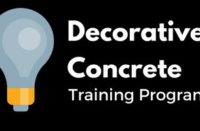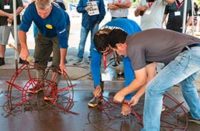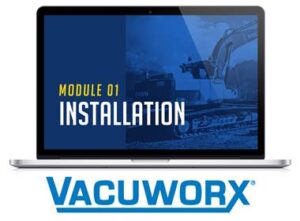Training in the construction industry seems more daunting than some other professions. With all of the moving parts of our industry, we not only need to train on skill and leadership, but also safety and technology. The decorative concrete industry thrives on innovation, so maintaining skilled craftsmen is crucial for success.

However, pulling craftsmen from the field to take time out to train involves commitment and long-term visioning because, honestly, it costs you and your company time and money in the short-term. So what makes training successful in our industry? The No. 1 way to ensure successful training is intentional commitment to training.
We, by no means, have mastered the art of training our employees. But, we have witnessed what works and what doesn’t. The most important training happens on the job site. However, it can be risky to rely solely on on-the-job training. It’s easy to become lazy about it.
You can throw new employees onto a job site and call it “on-the-job training,” knowing they’ll either sink or swim. Although this may work occasionally, it’s neither the most effective method, nor is it the most beneficial to you, your clients or your employees.
Successful on-the-job training requires a plan. Some elements of that plan may include:
A key person committed to mentoring the new hire. The only way our companies can grow is if we continue to train and develop the next generation of artisans. The best way to achieve this is to partner experienced craftsmen with rookies.
But these mentors must be patient and grasp the reality that they, too, once started as inexperienced as the new hires. They also need to understand that training someone else won’t threaten their own position but will make their crew even more valuable. In the long run, it’ll make the workload easier for everybody involved.
A check-in meeting every 30 days for the first three months. New hires need to feel valued and need reassurance and correction. Both should be done daily on the job, but a formal meeting once a month will also provide them a setting to see where they have already grown and where they are headed next.
These meetings can also be points of progressing pay increases if their employment and pay were based on an introductory wage with potential to grow with acquired skills (for example: obtaining a commercial driver’s license or excelling at finishing).
A 90-day introductory period. Research repeatedly shows many job site accidents happen within the first 90 days for a new employee. To help mitigate these accidents, you can use a different color T-shirt or hardhat to remind everyone that there is an inexperienced individual on the job site. We have used neon green shirts and a general contractor in Denver I know uses neon green hardhats.
Whichever method you choose, it serves as a helpful reminder. This identifier will visually remind your crew to take a little extra time with the individual to explain things, have more patience and to provide more support.
In addition to on-the-job training, it’s also valuable to bring employees in for more formal training. This is done best with face-to-face instruction rather than books or videos. The more interactive the class, between them and the instructor and between each other, the better.
Also, keep classroom time to a maximum of 45-minute segments to maximize their attention and retention. Once a month, we do foremen training where we have discussed topics such as safety, working with others and leadership styles, and toured a ready-mix plant. For many, we bring in outside experts to train our leaders.
Continuously investing in your employees is the best investment you can make for your company. Good employees are what keeps us all in business. If they grow, so will the company. And, in turn, if your employees see you value them and want them to be their best, their loyalty and continuously improving quality of work will provide you with a strong and growing company.















